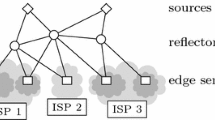Abstract
Video-on-Demand (VOD) or near-VOD services are expected to grow significantly over time, providing diverse programs for home entertainment, learning and training, news-on-demand, and other applications. These services require large bandwidth resources. We present a model for bandwidth allocation in a tree network with limited link capacities, where a server at the root node repeatedly broadcasts copies of various programs. The time intervals between successive broadcasts of each program can be increased at subsequent nodes, or the video quality can be decreased, thus providing different service performance to different nodes while satisfying the capacity constraints. The model is formulated as an equitable resource allocation problem with a lexicographic minimax objective function and tree-like ordering constraints. We present a lexicographic minimax algorithm that allocates each link’s bandwidth among the programs carried on the link. The algorithm repeatedly solves minimax problems, and fixes some variables at their optimal value after the solution of each such problem. The algorithm for solving the minimax problems uses a bisection search to find the minimax solution with the minimal decision variable values. The model also provides an ordered list of links from the most critical link to the least critical link, a useful feature for capacity expansion planning decisions.
Similar content being viewed by others
References
Balakrishnan A, Magnanti TL, Shulman A, Wong RT (1991) Models for planning capacity expansion in local access telecommunications networks. Ann Oper Res 33:239–284
Betts LM, Brown JR, Luss H (1994) Minimax resource allocation for problems with ordering constraints. Nav Res Logist 41:719–738
Brown JR (1994) Bounded knapsack sharing. Math Program 67:343–382
Carpenter T, Luss H (2006) Telecommunications access network design. In: Pardalos PM, Resende MGC (eds) Handbook of optimization in telecommunications, Chapter 13. Springer, New York, pp 313–339
Cidon I, Kutten S, Soffer R (2002) Optimal allocation of electronic content. Computer Networks 40:205–218
Dammicco G, Mocci U, Bordoni FU (1997) Optimal server location in VOD networks. Global Telecommunications Conference (GLOBECOM), IEEE 1, 197-201, 3–8 November.
Gavish B (1991) Topological design of telecommunications networks—local access design methods. Ann Oper Res 33:17–71
Hua KA, Tantaoui MA, Tavanapong W (2004) Video delivery technologies for large-scale deployment of multimedia applications. Proc IEEE 92:1439–1451 September
Hwang R-H, Chi P-H (2001) Fast optimal video placement algorithms for hierarchical video-on-demand systems. IEEE Trans Broadcast 47:357–366
Klein RS, Luss H, Smith DR (1992) A lexicographic minimax algorithm for multiperiod resource allocation. Math Program 55:213–234
Klincewicz JG (1998) Hub location in backbone/tributary network design: a review. Location Sci 6:307–335
Kostreva MM, Ogryczak W (1999) Linear optimization with multiple equitable criteria. RAIRO Oper Res 33:275–297
Laoutaris N, Zissimopoulos V, Stavrakakis I (2005) On the optimization of storage capacity allocation for content distribution. Computer Networks 47:409–428
Lee CY, Moon YP, Cho YJ (2004) A lexicographically fair allocation of discrete bandwidth for multirate malticast traffics. Computers and Operations Research 31:2349–2363
Li B, Golin MJ, Italiano GF, Deng X (1999) On the optimal placement of web proxies in the internet. Proceedings of IEEE INFOCOM 1999 Conference 3:1282–1290
Li B, Liu J (2003) Multirate video multicast over the internet: an overview. IEEE Netw, 24–29, January/February
Luss H (1999) On equitable resource allocation problems: a lexicographic minimax approach. Oper Res 47:361–378
Luss H, Smith DR (1988) Multiperiod allocation of limited resources: a minimax approach. Nav Res Logist 35:493–501
Luss H, Vakhutinsky A (2001) A resource allocation approach for the generation of service-dependent demand matrices for communications networks. Telecommunication Systems 17:411–433
Ramesh S, Rhee I, Guo K (2001) Multicast with cache (Mcache): an adaptive zero-delay video-on-demand service. IEEE Trans Circuits Syst Video Technol 11:440–456
Ryoo J-D, Panwar SS (2001) File distribution in networks with multimedia storage servers. Networks 38:140–149
Author information
Authors and Affiliations
Corresponding author
Rights and permissions
About this article
Cite this article
Luss, H. An Equitable Bandwidth Allocation Model for Video-on-Demand Networks. Netw Spat Econ 8, 23–41 (2008). https://doi.org/10.1007/s11067-007-9041-8
Published:
Issue Date:
DOI: https://doi.org/10.1007/s11067-007-9041-8




